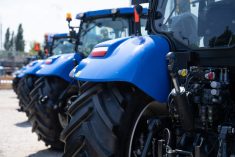The large keep getting larger, and they keep investing more, as well.
That’s the one-sentence summary from a new study from the Ivey School of Business Agri-food Innovation Centre. The study, Investment and Growth on Canadian Farms 2001-2009, has determined that Canadian farms saw total investments increase by more than $3 billion during the height of an economic recession that affected global markets and production.
By 2009, investment in Canadian farms jumped to $11.4 billion, compared to $8.2 billion in 2001.
In addition, the study found that large-scale farming operations saw the greatest increase in investments while medium and small farms spent less.
Read Also

Deere forecasts weak annual profit on tariff hit
Deere & Co forecast an annual profit below estimates on Wednesday, pressured by tariff impacts and weaker margins from its large tractors, sending the farm-equipment maker’s shares down nearly five per cent.
“As a group, Canadian farmers invest significant amounts of money in their farms, more money than they are making,” cited the study’s authors, David Sparling, chair of agri-food Innovation, and Nicoleta Uzea, a post-doctoral associate.
“In 2009, in the midst of an economic recession, total investments on Canada farms were 3.3 times their net operating income, up from twice the net income in 2001.”
On the other side of the investment picture, it was noted that capital investments on Canadian farms actually fell during the length of the study. In 2001, 60.2 per cent of farms made capital investments, but by 2009, that number was down to 52.9 per cent.
The study also confirmed the notion that size does matter, including the willingness to invest and the level of investment. On average, large farms with sales in excess of $500,000 showed a greater likelihood of investing, particularly compared to small- (sales of $10,000 to $249,999) and medium- ($250,000 to $499,999) sized farms.
It may come as little or no surprise that when Canadian farmers did invest, much of that money went to farm machinery. Larger farming operations also invested in farm real estate, stocks, bonds and other financial assets. At the other end of the economic spectrum, small and medium farms invested more in housing construction and environmental measures.
On a long-term basis, that gives larger farms an advantage in increased productivity and competitiveness leading to more opportunities — both from an incentive and resource perspective — to continue investing in the farm. That contrasts to what is likely to be continued erosion of smaller farms because of lesser productivity and competitiveness.
The report found four key policy implications:
- Despite spending on farm equipment, the question was whether money was spent in the most effective manner. Also, the investment by smaller farms in housing construction was deemed “unproductive,” and that it might be helpful to develop programs that assist farmers in optimizing their investments.
- With lesser amounts of money being invested by small and medium farms, there’s some uncertainty as to the effectiveness of business risk management programs. Did they serve to reduce farm income volatility (and effectively spread investment and growth on all farms)? Or did they simply put more money into the hands of larger and profitable farmers, potentially speeding the rate of consolidation in Canadian agriculture?
- As investments in environmental measures were low and unchanging, some sort of environmental cost-share programs should be improved. It was also stated that since small farms are critical to maintaining the environment and rural communities, more should be done to help small farms take advantage of these cost-sharing programs.
- Beef and hog producers have been struggling recently, so programs to help them modernize and improve their competitiveness should be examined.
This study offers further confirmation of initial research from 1994, which found a strong relationship between on-farm success and those farms which totalled $500,000 in annual revenues.
In that initial study, small farms were defined as those making $100,000 (not $10,000) to $249,999. But the outcome was similar; larger farm operations had greater opportunities for increasing efficiencies and competitiveness, relative to their small and medium counterparts. The second replication of that study was done by Agri Studies in Guelph, with the help of Ipsos Forward Research in 2010.
— Ralph Pearce is a field editor for Country Guide at St. Marys, Ont.
Table: Number of farms and total sales, net income and investments, by sales class, 2009 vs. 2001. Source: Statistics Canada, Farm Financial Survey 2001 to 2005, 2007 and 2009
| Revenue | Number of | Number of | Change (pct) |
| class ($) | farms, 2009 | farms, 2001 | 2009 to 2011 |
| 10,000 to 99,999 | 73,210 | 79,345 | -7.7 |
| 100,000 to 249,999 | 31,560 | 41,450 | -23.9 |
| 250,000 to 499,999 | 22,540 | 22,515 | 0.1 |
| 500,000 to 999,999 | 14,210 | 8,710 | 63.1 |
| 1,000,000 to 2,499,999 | 7,065 | 3,440 | 105.4 |
| >2,500,000 | 2,095 | 1,175 | 78.3 |
| Total | 150,680 | 156,635 | -3.8 |














